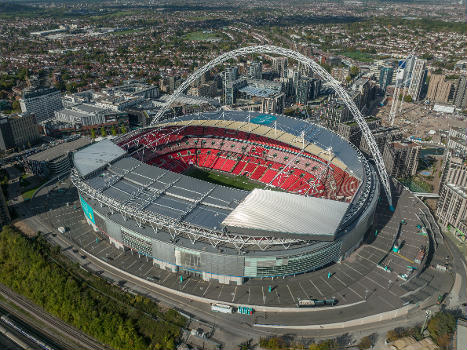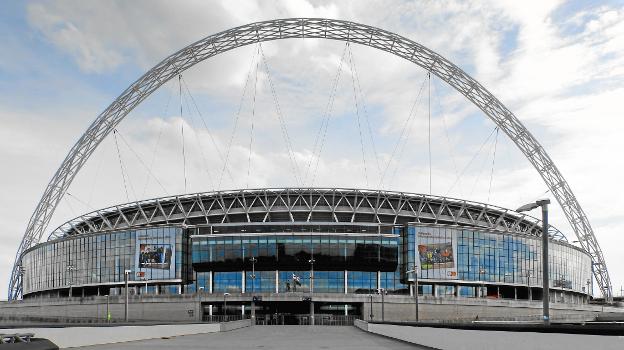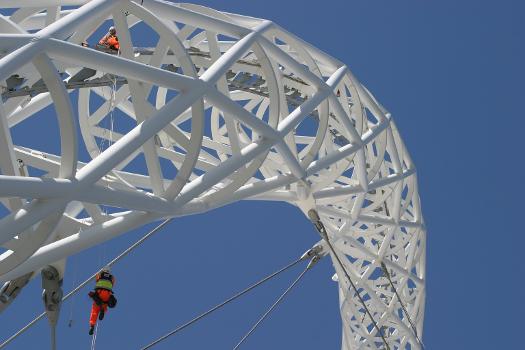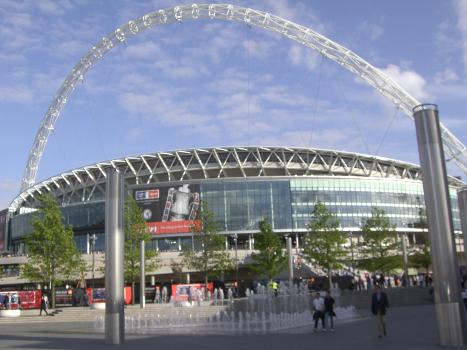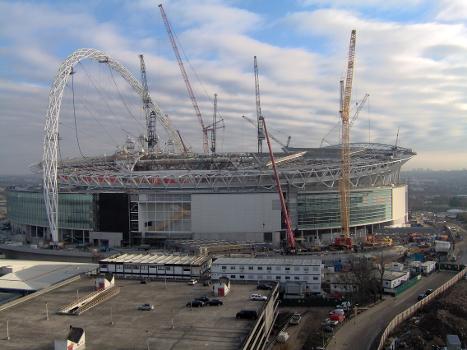General Information
Project Type
| Structure: |
Cable-supported structure |
|---|---|
| Function / usage: |
Stadium / Arena |
| Equipment: |
Structurae Plus/Pro - Subscribe Now! |
| Material: |
arch: Steel structure |
| Structure: |
arch: Truss arch |
Location
| Location: |
Brent, London, England, United Kingdom |
|---|---|
| Part of: | |
| Coordinates: | 51° 33' 21" N 0° 16' 47" W |
Technical Information
Dimensions
| seats | 90 000 | |
| building volume | 4 000 000 m³ | |
| arch | height | 133 m |
| weight | 1 750 t | |
| arch span | 315 m |
Quantities
| structural steel | 23 000 t |
Cost
| cost of construction | Pound sterling 789 000 000 |
Materials
| arch |
steel
|
|---|
Excerpt from Wikipedia
Wembley Stadium (branded as Wembley Stadium connected by EE for sponsorship reasons) is a football stadium in Wembley, London. It opened in 2007 on the site of the original Wembley Stadium, which was demolished from 2002 to 2003. The stadium hosts major football matches including home matches of the England national football team, and the FA Cup Final. Wembley Stadium is owned by the governing body of English football, the Football Association (the FA), whose headquarters are in the stadium, through its subsidiary Wembley National Stadium Ltd (WNSL). With 90,000 seats, it is the largest stadium in the UK and the second-largest stadium in Europe.
Designed by Populous and Foster and Partners, the stadium is crowned by the 134-metre-high (440 ft) Wembley Arch which serves aesthetically as a landmark across London as well as structurally, with the arch supporting over 75% of the entire roof load. The stadium was built by Australian firm Multiplex at a cost of £798 million (£1.2 billion today). Contrary to popular belief, Wembley Stadium does not have a retractable roof which covers the playing surface. Two partially retractable roof structures over the east and west end of the stadium can be opened to allow sunlight and aid pitch growth.
In addition to England home games and the FA Cup final, the stadium also hosts other major games in English football, including the season-opening FA Community Shield, the League Cup final, the FA Cup semi-finals, the Football League Trophy, the Football League play-offs, the FA Trophy, the FA Vase and the National League play-offs. A UEFA category four stadium, Wembley hosted the 2011 and 2013 UEFA Champions League Finals, and will host eight games at UEFA Euro 2020, (including the final and both of the semi-finals), as well as the original venue of the 2023 UEFA Champions League Final. It was later relocated to the Allianz Arena in Munich due to adjustments of the 2020 final caused by the COVID-19 pandemic in Europe. It will stage the following season's final instead. The stadium hosted the Gold medal matches at the 2012 Olympic Games football tournament. The stadium also hosts rugby league's Challenge Cup final and music concerts. The stadium also hosted NFL London Games until 2019 and was also the temporary home of Premier League football club Tottenham Hotspur between August 2017 and March 2019, while White Hart Lane was being demolished and their new stadium was constructed.
In 2014, Wembley Stadium entered into a six-year sponsorship agreement with mobile provider EE Limited, under which it provides technology and infrastructure services for the venue. Under the agreement, the facility is officially referred to as "Wembley Stadium connected by EE".
Stadium
Wembley was designed by architects Foster + Partners and HOK Sport (now Populous) and with engineers Mott Stadium Consortium, who were a collection of three structural engineering consultants in the form of Mott MacDonald, Sinclair Knight Merz and Aurecon. The design of the building services was carried out by Mott MacDonald. The construction of the stadium was managed by Australian company Multiplex and funded by Sport England, WNSL (Wembley National Stadium Limited), the Football Association, the Department for Digital, Culture, Media and Sport and the London Development Agency. It is one of the most expensive stadia ever built at a cost of £798 million in 2007, and has the largest roof-covered seating capacity in the world. Nathaniel Lichfield and Partners was appointed to assist Wembley National Stadium Limited in preparing the scheme for a new stadium and to obtain planning and listed building permission for the development.
The all-seater stadium is a bowl design with a capacity of 90,000, protected from the elements by a sliding roof that does not completely enclose it. It can also be adapted as an athletic stadium by erecting a temporary platform over the lowest tier of seating. The stadium's signature feature is a circular section lattice arch of 7 m (23 ft) internal diameter with a 315 m (1,033 ft) span, erected some 22° off true, and rising to 133 m (436 ft). It supports all the weight of the north roof and 60% of the weight of the retractable roof on the southern side. The arch is the world's longest unsupported roof structure.
A "platform system" has been designed to convert the stadium for athletics use, but its use would decrease the stadium's capacity to approximately 60,000. No athletics events (track and field) have taken place at the stadium; the conversion for athletics use was a condition of part of the lottery funding the stadium received, but to convert it would take weeks of work and cost millions of pounds. Instead, with the awarding of the 2012 Summer Olympic Games to London in 2005, the London Olympic Stadium has been used for major athletics events since 2012.
Construction
The initial plan for the reconstruction of Wembley was for demolition to begin before Christmas 2000, and for the new stadium to be completed some time during 2003, but this work was delayed by a succession of financial and legal difficulties. In 2004, London Mayor Ken Livingstone and Brent Council also announced wider plans for the regeneration of Wembley, taking in the arena and the surrounding areas as well as the stadium, to be implemented over two or three decades. Demolition officially began on 30 September 2002, with the Twin Towers being dismantled in December 2002.
Delays to the construction project started as far back as 2003. In December 2003, the constructors of the arch, subcontractors Cleveland Bridge & Engineering Company of Darlington, warned Multiplex about rising costs. Cleveland Bridge withdrew from the project and replaced by Dutch firm Hollandia with all the attendant problems of starting over. 2004 also saw errors, most notably a fatal accident involving carpenter Patrick O'Sullivan for which construction firm PC Harrington Contractors were fined £150,000 in relation to breaches of health and safety laws.
In October 2005, Sports Minister Richard Caborn announced: "They say the Cup Final will be there, barring six feet of snow or something like that". By November 2005, WNSL were still hopeful of a handover date of 31 March, in time for the cup final on 13 May. However, in December 2005, the builders admitted that there was a "material risk" that the stadium might not be ready in time for the final. In February 2006 these worries were confirmed, with the FA moving the game to Cardiff's Millennium Stadium.
On 20 March 2006, a steel rafter in the roof of the new development fell by 1+1⁄2 ft (46 cm), forcing 3,000 workers to evacuate the stadium and raising further doubts over the completion date which was already behind schedule. On 23 March 2006, sewers beneath the stadium buckled due to ground movement. GMB Union leader Steve Kelly said that the problem had been caused by the pipes not being properly laid, and that the repair would take months. Rumours circulated that the reason for the blockage was due to Multiplex failing to pay the contractors who laid the pipes who then filled in the pipes with concrete. A spokesman for developers Multiplex said that they did not believe this would "have any impact on the completion of the stadium", which was then scheduled to be completed on 31 March 2006.
On 30 March 2006, the developers announced that Wembley Stadium would not be ready until 2007. All competitions and concerts planned were to be moved to suitable locations. On 19 June 2006, it was announced that the turf had been laid. On 19 October 2006 it was announced that the venue was now set to open in early 2007 after the dispute between the Football Association and Multiplex had finally been settled. WNSL was expected to pay around £36m to Multiplex, on top of the amount of the original fixed-price contract. The total cost of the project (including local transport infrastructure redevelopment and the cost of financing) was estimated to be £1 billion.
For the new stadium the level of the pitch was lowered. During excavation of the new playing field, mechanical diggers unearthed a buried obstruction: the concrete foundations of Watkin's Tower, a failed attempt to construct a rival to the Eiffel Tower in London. Only the base of the tower was ever built before being abandoned and demolished in 1907; the site was later used as the location for the first Wembley Stadium.
Handover and opening
The new stadium was completed and handed over to the FA on 9 March 2007. The official Wembley Stadium website had announced that the stadium would be open for public viewing for local residents of Brent on 3 March 2007, however this was delayed by two weeks and instead happened on 17 March.
While the stadium had hosted football matches since the handover in March, the stadium was officially opened on Saturday 19 May, with the staging of the 2007 FA Cup Final. Eight days before that on Friday 11 May, the statue of Bobby Moore had been unveiled by his former England team-mate Sir Bobby Charlton outside the stadium entrance, as the "finishing touch" to the completion of the stadium. The twice life-size bronze statue, sculpted by Philip Jackson, depicts England's 1966 World Cup winning captain Bobby Moore, looking down Wembley Way.
Structure
- The stadium contains 2,618 toilets, more than any other venue in the world.
- The stadium has a circumference of 1 km (0.62 mi).
- The bowl volume is listed at 1,139,100 m³ (1,489,900 cu yd), somewhat smaller than the Millennium Stadium in Cardiff, but with a greater seating capacity.
- At its peak, there were more than 3,500 construction workers on site.
- 4,000 separate piles form the foundations of the new stadium, the deepest of which is 35 m (115 ft).
- There are 56 km (35 mi) of heavy-duty power cables in the stadium.
- 90,000 m³ (120,000 cu yd) of concrete and 23,000 tonnes (25,000 short tons) of steel were used in the construction of the new stadium.
- The total length of the escalators is 400 metres (1⁄4 mi).
- The arch has a cross-sectional diameter greater than that of a cross-channel Eurostar train.
Pitch
The pitch size, as lined for association football, is 115 yd (105 m) long by 75 yd (69 m) wide, slightly narrower than the old Wembley, as required by the UEFA stadium categories for a category four stadium, the top category.
In a period after the completion of the new Wembley, the pitch came into disrepute. It was described as being "no good" and "not in the condition that Wembley used to be known for" by Slaven Bilić before a game between England and the team he managed, Croatia, in November 2007. The pitch was cut up during the game, which was blamed by some as the reason England did not qualify for UEFA Euro 2008. The Football Association admitted in April 2009, after the FA Cup semi-finals, that improvements were needed to the Wembley pitch, after criticism of the surface by coaches Sir Alex Ferguson, Arsène Wenger and David Moyes.
In March 2010, the surface was relaid for the tenth time since opening. In April 2010, the pitch was again criticised following the FA Cup semi-finals, during which the players found it difficult to keep their footing and the surface cut up despite the dry conditions. The then Tottenham Hotspur boss, Harry Redknapp labelled it a "disgrace" after his side's semi-final defeat to Portsmouth. After the 2010 FA Cup Final, Chelsea captain John Terry said, "The pitch ruined the final. It's probably the worst pitch we've played on all year. It was not good enough for a Wembley pitch." The stadium was then relaid with a Desso GrassMaster semi-artificial pitch, ahead of the 2010 community shield game between Chelsea and Manchester United. Michael Owen, who previously criticised the pitch for causing him injury, said that it was much improved.
Wembley is used for American Football matches in the National Football League's International Series. Tottenham Hotspur hosted Manchester City in a Premier League match on 29 October 2018, a day after Wembley hosted the Philadelphia Eagles and Jacksonville Jaguars. Due to the short turnaround, faded gridiron markings and the NFL logo were clearly visible on the pitch along with worn grass along the centre of the pitch and the touch-lines. Tottenham were forced to hold the match at Wembley due to construction delays to their new ground. Despite the pitch's condition, UEFA allowed a Champions League leg to be played at Wembley on 9 November 2018 with Tottenham hosting Dutch side PSV Eindhoven.
Covering
The stadium roof has an area of 40,000 m² (430,000 sq ft), of which 13,722 m² (147,700 sq ft) is movable. The primary reason for the sliding roof was to avoid shading the pitch, as grass demands direct sunlight to grow effectively. The sliding roof design minimises the shadow by having the roof pulled back on the east, west and south. Angus Campbell, the chief architect, also said that an aim was for the pitch to be in sunlight during matches played between 3 pm and 5 pm from the beginning of May to the end of June, when the FA and World Cups would be played. However, it was mentioned during live commentary of the mid-May 2007 FA Cup Final that the pitch was in partial shade at the start at 3 pm and also during the match.
The stadium roof rises to 52 metres (171 ft) above the pitch and is supported by an arch rising 133 m (436 ft) above the level of the external concourse. With a span of 315 m (1,033 ft), the arch is the longest single-span roof structure in the world.
Litigation
The Australian firm Multiplex, which was the main contractor on Wembley Stadium, made significant losses on the project. In an attempt to recoup some of those losses, the firm initiated a number of legal cases against its sub-contractors and consultants. The largest of these – the largest construction claim in UK legal history – was a claim for £253 million against the structural engineering consultants Mott MacDonald.
In preliminary hearings the two architecture practices which worked for Multiplex on the project were ordered to allow Multiplex access to their records for them to build a case. The practices, Foster + Partners and Populous, estimated the costs of providing access and answering Multiplex's queries at £5 million. Mott MacDonald issued a counter-claim for unpaid fees of £250,000.
The dispute between Multiplex and Mott MacDonald was settled out of court in June 2010, ahead of a January 2011 trial. The terms of the settlement not disclosed, but it was reported that Multiplex "would not be out of pocket".
Multiplex also took the original steel contractor, Cleveland Bridge, to court claiming £38 million compensation for costs resulting from Cleveland Bridge withdrawing from the project. Cleveland Bridge, in turn, claimed up to £15 million from Multiplex. The case was resolved in September 2008 with Cleveland Bridge ordered to pay £6.1 million in damages and 20% of Multiplex's costs, after the court found against Cleveland Bridge. The judge criticised both sides for allowing the case to reach court, pointing out that total costs were £22 million, including £1 million for photocopying. Multiplex's ultimate bill is estimated to be over £10 million. In 2007, Multiplex also contested a claim from its concrete contractor, PC Harrington, that Multiplex owes £13.4 million to PC Harrington.
Text imported from Wikipedia article "Wembley Stadium" and modified on June 12, 2021 according to the CC-BY-SA 4.0 International license.
Participants
Relevant Web Sites
Relevant Publications
- L'arche du stade de Wembley dans les airs. In: Le Moniteur des Travaux Publics et du Bâtiment, n. 5250 (9 July 2004), pp. 21.
- DYWIDAG Permanent Multistrand Ties for the new Wembley Stadium. The new Wembley Stadium, Wembley, England. In: DSI Info, n. 13 ( 2005- 2006), pp. 43-45.
- DYWIDAG-Dauerlitzen-Zuganker für das neue Wembley-Stadion. Das neue Wembley-Stadion, Wembley, England. In: DSI Info, n. 13 ( 2005- 2006), pp. 43-45.
- : An Engineer's Guide to Interesting Structures in London. Arranged for Walking Tours. pp. 50-51.
- Remise des clés du stade de Wembley. In: Le Moniteur des Travaux Publics et du Bâtiment, n. 5391 (23 March 2007), pp. 9.
- About this
data sheet - Structure-ID
20006505 - Published on:
30/10/2002 - Last updated on:
19/06/2024

